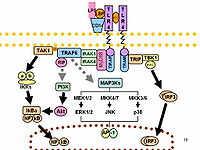
Photo from wikipedia
Waldenstr€ om Macroglobulinaemia (WM) is a B-cell malignancy characterized by bone marrow (BM) infiltration with lymphoplasmacytic lymphoma and production of a monoclonal immunoglobulin (Ig) M protein (Owen et al, 2003).… Click to show full abstract
Waldenstr€ om Macroglobulinaemia (WM) is a B-cell malignancy characterized by bone marrow (BM) infiltration with lymphoplasmacytic lymphoma and production of a monoclonal immunoglobulin (Ig) M protein (Owen et al, 2003). The tumour cell population in WM is markedly heterogeneous, reflecting mature B-lymphocytes that retain the ability to differentiate into plasmacytoid lymphocytes and plasma cells, though the distribution of the malignant clone within individual patients can vary. Two subsets of malignant WM cells are readily identifiable by flow cytometry in BM aspirates: monotypic B lymphocytes that are CD19, CD20, CD22, CD38 , and monotypic plasma cells that are CD19 , CD20 , CD22 , CD38 (Paiva et al, 2014). Given the wide spectrum of B-cell differentiation exhibited in WM, there can be great overlap with other IgM secreting B-cell malignancies thereby posing a diagnostic challenge. MYD88 L265P is a highly prevalent (93–95%) somatic mutation in WM that was first revealed by whole genome sequencing (Treon et al, 2012). MYD88 L265P is absent or rarely expressed in patients with other types of B-cell malignancies, which share many clinical and pathological features with WM, such as marginal zone lymphoma, chronic lymphocytic leukaemia and IgM myeloma (Varettoni et al, 2013; Xu et al, 2013). The ability to use MYD88 L265P to support the diagnosis of WM has led to its adoption in World Health Organization, National Comprehensive Cancer Network and WM Workshop Consensus guidelines. Rare non-L265P MYD88 mutations may also be present in WM patients (Treon et al, 2015). The presence of MYD88 mutations is also associated with longer overall survival, as well as higher overall and major response rates to ibrutinib, the only US Food and Drug Administration and European Medicines Agency approved therapy for WM (Treon et al, 2014, 2015). As such, determination of MYD88 mutational status can convey important diagnostic, prognostic and predictive data for treatment response in WM. Allele-specific polymerase chain reaction (AS-PCR) is widely used for the detection of MYD88 L265P, and offers a higher level of sensitivity over Sanger sequencing. However, some series have used sorted B-cells to detect MYD88 L265P, whereas others used unselected BM mononuclear cells. The use of sorted B-cells versus unsorted BM mononuclear cells for the optimal detection of MYD88 L265P by AS-PCR remains unclear, though in peripheral blood (PB) the use of sorted B-cells greatly improved detection of MYD88 L265P over unselected PB mononuclear cells (Xu et al, 2014). In clinical laboratories, the ability to pre-sort B-cells poses a time and economic challenge, hence testing is almost always
Journal Title: British Journal of Haematology
Year Published: 2017
Link to full text (if available)
Share on Social Media: Sign Up to like & get
recommendations!